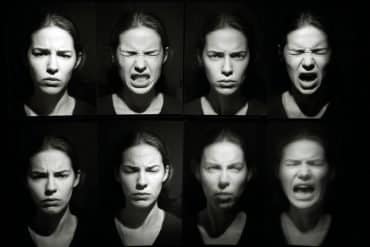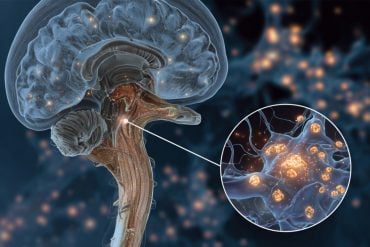Summary: Using EEG to measure beta waves shows promise in detecting Parkinson’s disease in a non-invasive way.
Source: University of Oregon
Specific angles and sharpness of brain waves seen in unfiltered raw data from scalp electroencephalograms have been tied to Parkinson’s disease.
Reporting in the online journal eNeuro, researchers suggest that noninvasive EEG readings may provide easily detectable electrophysiological biomarkers to aid the diagnosis and fine-tune therapeutic treatments for the disease and potentially other motor disorders.
“Using this safe and affordable way to measure and quantify brain activity, we were able to distinguish differences between Parkinson’s patients who were on and off medications and in comparisons with healthy people,” said the study’s principal investigator Nicole Swann of the Department of Human Physiology at the University of Oregon.
The initial diagnosis of Parkinson’s disease currently relies on a neurologist’s assessment of patients performing a series of body-movement tasks. Such subjective testing, however, can lead to misdiagnosis.
“We don’t know yet whether this approach will be better, but it could provide easily obtained brain measurements that would be helpful and possibly used in tandem with clinical observations and other EEG measurements,” Swann said.
Previous efforts to detect Parkinson’s disease in EEG brain waves have been inconsistent, she said, because the focus has been on measures which model brain signals as sine waves, which are beta waves filtered to round the waves and show the overall power of periodic oscillations. Novel methods like the one used here currently have only been shown to relate to Parkinson’s disease with electrodes surgically implanted in patients’ brains.
In the new analysis of scalp EEG data, previously collected at the University of California San Diego from 15 Parkinson’s patients and 16 healthy control participants, Swann focused on the original unfiltered beta waves to look for specific angles and full shape of the oscillations. Co-author Scott Cole, a doctoral student at UC San Diego in 2017, had noticed that people with Parkinson’s disease appear to have sharp brain waves, suggesting a new look was warranted.
“The raw signals go up and down like sine waves but with more asymmetry,” Swann said. “The steepness – the slant – turns out to be important in Parkinson’s patients. This was easily detectable in the patients who are off medication.”
When the peak is sharper at the top of the wave than in the trough, or low part of the oscillation, it is indicative of patients who are off their medications, she said.
In a large follow-up study, Swann said she hopes to combine scalp EEG measurements with detailed medical histories and self-reports of how patients are feeling on each day of testing. Eventually, it is hoped the approach could help detect changes in the disease in individuals over time.
Current treatment involves surgery to permanently implant an electric stimulator or a pharmacological approach in which dosage titration is difficult and often results in frustrating cycling of effectiveness, said study co-author Bradley Voytek, a neuroscientist at UC San Diego, in whose lab Cole, who has since earned his doctorate, had worked.
“If there were real-time measures of how effective treatments are at reducing the negative symptoms of Parkinson’s disease, treatments could be adjusted in real-time,” Voytek said. “In the case of an invasive brain stimulator, this might mean only applying electric stimulation when it’s needed. In the case of pharmacology, it would mean adjusting a drug’s dose much like continuous glucose monitoring done by an implant can signal a pump to adjust insulin levels as needed.”
Ideally, Swann said, if the approach proves to provide robust information, EEG testing could be remotely done by Parkinson’s patients wearing a hat fitted with electrodes. Results could be sent to their neurologists and used to quickly and easily adjust treatments.

A challenge, Voytek said, is that real-time measures of brain activity are often noisy and can cloud the ability to capture the correct signals.
“A lot of the tools we have for measuring them take a lot of processing power, so they can’t easily be applied in real-time,” he said.
Funding: This work was supported by grants from the National Science Foundation, Whitehall Foundation and Sloan Foundation to Cole and Voytek.
The study’s first author was Nick Jackson, a lab technician in Swann’s UO lab who is now pursuing a doctoral degree at the University of Texas at Austin.
Source:
University of Oregon
Media Contacts:
Jim Barlow – University of Oregon
Image Source:
The image is in the public domain.
Original Research: Open access
“Characteristics of Waveform Shape in Parkinson’s Disease Detected with Scalp Electroencephalography”. Nicko Jackson, Scott R. Cole, Bradley Voytek and Nicole C. Swann.
Biological Psychology. doi:10.1523/ENEURO.0151-19.2019
Abstract
Characteristics of Waveform Shape in Parkinson’s Disease Detected with Scalp Electroencephalography
Neural activity in the beta frequency range (13-30 Hz) is excessively synchronized in Parkinson’s Disease (PD). Previous work using invasive intracranial recordings and non-invasive scalp electroencephalography (EEG) has shown that correlations between beta phase and broadband gamma amplitude (i.e., phase-amplitude coupling) are elevated in PD, perhaps a reflection of this synchrony. Recently, it has also been shown, in invasive human recordings, that nonsinusoidal features of beta oscillation shape also characterize PD. Here we show that these features of beta waveform shape also distinguish PD patients on and off medication using non-invasive recordings in a dataset of 15 PD patients with resting scalp EEG. Specifically, beta oscillations over sensorimotor electrodes in PD patients off medication had greater sharpness asymmetry and steepness asymmetry than on medication (sign rank, p<0.02, corrected). We also showed that beta oscillations over sensorimotor cortex most often had a canonical shape, and that using this prototypical shape as an inclusion-criteria increased the effect size of our findings. Together our findings suggest that novel ways of measuring beta synchrony that incorporates waveform shape could improve detection of PD pathophysiology in non-invasive recordings. Moreover, they motivate the consideration of waveform shape in future EEG studies.
Significance Statement
Diagnosis and long-term monitoring of Parkinson’s disease (PD) is mainly assessed via clinical rating scales which are subjective and can be imprecise. An objective measure of PD would be extremely valuable, especially one that could be acquired non-invasively. Here we show, using scalp electroencephalography (EEG), that the nonsinusoidal shape of beta (13-30 Hz) oscillations over sensorimotor cortex distinguish PD patients on and off medication and patients off medication from controls. This change in waveform shape may reflect hypersynchronous input, possibly originating from basal ganglia. Thus, waveform shape is a putative non-invasive electrophysiology biomarker of PD state with potential utility for assessing treatments, monitoring disease, or diagnosis. This signature can be detected with a safe, affordable, and available method (i.e. EEG).






